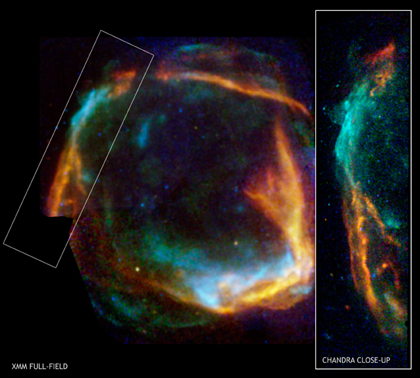For Release: September 18, 2006
CXC RELEASE 06-05
Recent observations have uncovered evidence that helps to confirm the identification of the remains of one of the earliest stellar explosions recorded by humans.
The new study shows that the supernova remnant RCW 86 is much younger than previously thought. As such, the formation of the remnant appears to coincide with a supernova observed by Chinese astronomers in 185 A.D. The study used data from NASA's Chandra X-ray Observatory and the European Space Agency's XMM-Newton Observatory,
"There have been previous suggestions that RCW 86 is the remains of the supernova from 185 A.D.," said Jacco Vink of University of Utrecht, the Netherlands, and lead author of the study. "These new X-ray data greatly strengthen the case."
When a massive star runs out of fuel, it collapses on itself, creating a supernova that can outshine an entire galaxy. The intense explosion hurls the outer layers of the star into space and produces powerful shock waves. The remains of the star and the material it encounters are heated to millions of degrees and can emit intense X-ray radiation for thousands of years.
In their stellar forensic work, Vink and colleagues studied the debris in RCW 86 to estimate when its progenitor star originally exploded. They calculated how quickly the shocked, or energized, shell is moving in RCW 86, by studying one part of the remnant. They combined this expansion velocity with the size of the remnant and a basic understanding of how supernovas expand to estimate the age of RCW 86.
"Our new calculations tell us the remnant is about 2,000 years old," said Aya Bamba, a coauthor from the Institute of Physical and Chemical Research (RIKEN), Japan. "Previously astronomers had estimated an age of 10,000 years."
The younger age for RCW 86 may explain an astronomical event observed almost 2000 years ago. In 185 AD, Chinese astronomers (and possibly the Romans) recorded the appearance of a new bright star. The Chinese noted that it sparkled like a star and did not appear to move in the sky, arguing against it being a comet. Also, the observers noticed that the star took about eight months to fade, consistent with modern observations of supernovas.
RCW 86 had previously been suggested as the remnant from the 185 AD event, based on the historical records of the object's position. However, uncertainties about the age provided significant doubt about the association.
"Before this work I had doubts myself about the link, but our study indicates that the age of RCW 86 matches that of the oldest known supernova explosion in recorded history," said Vink. "Astronomers are used to referencing results from 5 or 10 years ago, so it's remarkable that we can build upon work from nearly 2000 years ago."
The smaller age estimate for the remnant follows directly from a higher expansion velocity. By examining the energy distribution of the X-rays, a technique known as spectroscopy, the team found most of the X-ray emission was caused by high-energy electrons moving through a magnetic field. This is a well-known process that normally gives rise to low-energy radio emission. However, only very high shock velocities can accelerate the electrons to such high energies that X-ray radiation is emitted.
"The energies reached in this supernova remnant are extremely high," said Andrei Bykov, another team member from the Ioffe Institute, St. Peterburg, Russia. "In fact, the particle energies are greater than what can be achieved by the most modern particle accelerators."
The difference in age estimates for RCW 86 is due to differences in expansion velocities measured for the supernova remnant. The authors speculate that these variations arise because RCW 86 is expanding into an irregular bubble blown by a wind from the progenitor star before it exploded. In some directions, the shock wave has encountered a dense region outside the bubble and slowed down, whereas in other regions the shock remains inside the bubble and is still moving rapidly. These regions give the most accurate estimate of the age.
The study describing these results appeared in the September 1 issue of The Astrophysical Journal Letters. NASA's Marshall Space Flight Center, Huntsville, Ala., manages the Chandra program for the agency's Science Mission Directorate. The Smithsonian Astrophysical Observatory, Cambridge, Mass., controls science and flight operations from the Chandra X-ray Center, Cambridge, Mass. XMM-Newton is an European Space Agency science mission managed at the European Space Research and Technology Centre, Noordwijk, the Netherlands for the Directorate of the Scientific Programme.
Additional information and images are available at:
MEDIA CONTACTS
Steve Roy
Marshall Space Flight Center, Huntsville, Ala.
(Phone: 256/544-6535)
Megan Watzke
Chandra X-ray Center, Cambridge, Mass.
(Phone: 617/496-7998)




